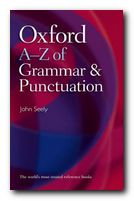pocket guide to the basics of English language
Most people are a bit frightened of grammar and punctuation – with some reason, because both can be very complex issues. Fortunately, anybody who can speak their own language is already in possession of all the tools they need for using it correctly. This isn’t to say that we don’t need a little help from time to time. And that’s where guides like this one come in useful. John Seely starts off with a brief overview of English sentence structure, and how the parts relate to each other. He explains all the main elements of speech, and uses everyday examples as illustrations. Then it’s on to the main substance of the book, which starts at abbreviations and runs via main clause to who’s/whose and will/shall. In between, he covers all the main issues which crop up time and again as problems for everyday users of English.
 How do you punctuate lists of terms? How can you avoid the split infinitive? What is the rule for using apostrophes? What is the difference between can and may? What’s the correct way to show speech in writing? Is between you and me correct English? Answer: yes it is.
How do you punctuate lists of terms? How can you avoid the split infinitive? What is the rule for using apostrophes? What is the difference between can and may? What’s the correct way to show speech in writing? Is between you and me correct English? Answer: yes it is.
He uses a minimum of jargon, and makes all his explanations as succinct as possible. I particularly liked one visual feature of this book. Longer topics, such as paragraphs and prefixes are given their own shaded boxes, and somehow this makes both the topic and its surrounding items easier to read.
This book will be ideal if you want a reference offering quick simple explanations, but you could also use it as an introduction to a more in-depth study of the subject.
This is a new series from OUP – a pocketbook guides on the basics of writing and language skills. They’re small, cheap, cheerful, and compact, yet authoritative – the sort of thing which I imagine would be ideal for students or the average person-in-the-street who wants to take on the first principles of improving their language skills.
© Roy Johnson 2009
John Seely, Oxford A—Z of Grammar and Punctuation, Oxford: Oxford University Press, 2nd edition 2009, pp.192, ISBN: 0199564671
More on writing skills
More on language
More on grammar
